A Review on the Out-of-Autoclave Process for Composite Manufacturing
Abstract
:1. Introduction
2. Prepreg
3. Vacuum Bagging
4. Vacuum Bag Only (VBO)/Oven Cure
5. Resin Transfer Molding (RTM)
6. Vacuum Assisted Resin Transfer Molding (VARTM)
7. Quickstep Curing
7.1. Melding
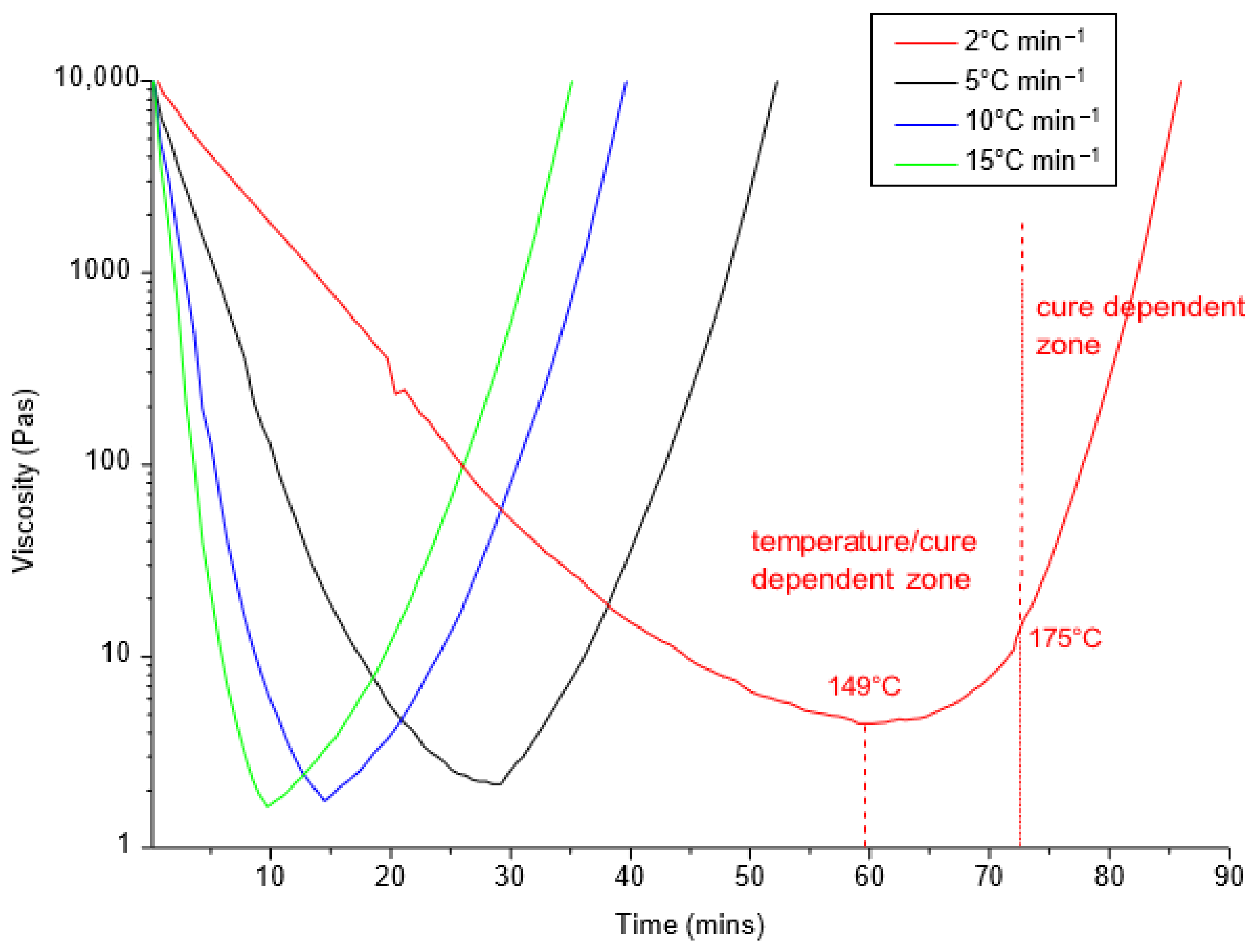
| Composite System | Manufacturing Process | Fiber Vol Fraction | Void Content | ILSS | Flexural Strength | Ref. |
|---|---|---|---|---|---|---|
| Hexply 6376 prepreg | Autoclave | 64.1 | 0.6 | 111 | 1923 | [88] |
| Quickstep | 60.2 | 1.8 | 115 | 1755 | ||
| Hot press | ||||||
| Hexply 6376 prepreg | Autoclave | 64.1 | <1 | 111 | 1923 | [99] |
| Quickstep | 62.3 | <1 | 121 | 1755 | ||
| Hot press | ||||||
| Carbon fiber/epoxy 914/40/G703 | Autoclave | 75 | [84] | |||
| Quickstep | 83 | |||||
| Hot press | ||||||
| Hexply 914 carbon fiber/epoxy | Autoclave | 54.86 | [100] | |||
| Quickstep | 52.17 | |||||
| Hot press | ||||||
| Toughened epoxy resin MTM 45 | Autoclave | [101] | ||||
| Quickstep | 77.3 | |||||
| Hot press | 71.3 | |||||
| Cytec cyom 977-2A prepreg | Autoclave | [87] | ||||
| Quickstep | 60 | 1.70 | 84 | 1258 | ||
| Hot press | 61.4 | 1.04 | 82 | 1332 | ||
| Hexply M18/1carbon fiber epoxy | Autoclave | 64.2 | [102] | |||
| Quickstep | 72.2 | |||||
| Hot press |
7.2. Other Quickstep Applications
8. Seeman Composite Resin Infusion Molding Process (SCRIMP)
9. Resin Film Infusion (RFI)
10. Resin Infusion under Double Flexible Tooling (RIDFT)
11. Future Research Direction
12. Conclusions
Author Contributions
Funding
Informed Consent Statement
Data Availability Statement
Conflicts of Interest
References
- Kumar, K.V. Study on Alternate Resins for Wet Lay up of Cfrp Laminates. Int. J. Appl. Eng. Res. 2015, 10, 32696–32700. [Google Scholar]
- Yashas Gowda, T.G.; Sanjay, M.R.; Subrahmanya Bhat, K.; Madhu, P.; Senthamaraikannan, P.; Yogesha, B. Polymer Matrix-Natural Fiber Composites: An Overview. Cogent Eng. 2018, 5, 1446667. [Google Scholar] [CrossRef]
- Chukov, D.; Nematulloev, S.; Zadorozhnyy, M.; Tcherdyntsev, V.; Stepashkin, A.; Zherebtsov, D. Structure, Mechanical and Thermal Properties of Polyphenylene Sulfide and Polysulfone Impregnated Carbon Fiber Composites. Polymers 2019, 11, 684. [Google Scholar] [CrossRef] [PubMed] [Green Version]
- Mallick, P.K. Fiber-Reinforced Composites: Materials, Manufacturing, and Design, 3rd ed.; [Expanded and Rev. ed.]; CRC Press: Boca Raton, FL, USA, 2008; ISBN 978-0-8493-4205-9. [Google Scholar]
- Aboudi, J.; Arnold, S.; Bednarcyk, B. Micromechanics of Composite Materials; Springer Science & Business Media: Berlin/Heidelberg, Germany, 2013; ISBN 9780123970350. [Google Scholar]
- Hollaway, L.C. The Evolution of and the Way Forward for Advanced Polymer Composites in the Civil Infrastructure. Constr. Build. Mater. 2003, 17, 365–378. [Google Scholar] [CrossRef]
- Beardmore, P. Composite Structures for Automobiles. Compos. Struct. 1986, 5, 163–176. [Google Scholar] [CrossRef]
- Erden, S.; Ho, K. Fiber Reinforced Composites. In Fiber Technology for Fiber-Reinforced Composites; CRC Press: Boca Raton, FL, USA, 2017; pp. 51–79. [Google Scholar] [CrossRef]
- Mortensen, A. Interfacial Phenomena in the Solidification Processing of Metal Matrix Composites. Mater. Sci. Eng. A 1991, 135, 1–11. [Google Scholar] [CrossRef]
- Mazumdar, S.K. Composites Composites; CRC Press: Boca Raton, FL, USA, 2002; ISBN 0-8493-0585-3. [Google Scholar]
- Shenoi, R. Design of Ships and Marine Structures Made from FRP Composite Materials. Compr. Compos. Mater. 2001, 6, 429–449. [Google Scholar]
- Schwartz, M.M. Encyclopedia of Materials, Parts, and Finishes, 2nd ed.; CRC Press: Boca Raton, FL, USA, 2002; ISBN 978-1-56676-661-6. [Google Scholar]
- Panthapulakkal, S.; Raghunanan, L.; Sain, M.; Kc, B.; Tjong, J. Natural Fiber and Hybrid Fiber Thermoplastic Composites: Advancements in Lightweighting Applications; Woodhead Publishing: Sawston, UK, 2017; ISBN 9780081008003. [Google Scholar]
- Lancaster, J.F. Brazing, Soldering and Adhesive Bonding. In Metallurgy of Welding; Springer: Dordrecht, The Netherlands, 1980; pp. 87–109. [Google Scholar] [CrossRef]
- Lotfi, A.; Li, H.; Dao, D.V.; Prusty, G. Natural Fiber–Reinforced Composites: A Review on Material, Manufacturing, and Machinability. J. Thermoplast. Compos. Mater. 2021, 34, 238–284. [Google Scholar] [CrossRef]
- Hubert, P.; Fernlund, G.; Poursartip, A. Autoclave Processing for Composites; Woodhead Publishing Limited: Sawston, UK, 2012. [Google Scholar]
- Hjellming, L.N.; Walker, J.S. Thermal Curing Cycles for Composite Cylinders with Thick Walls and Thermoset Resins. J. Compos. Mater. 1989, 23, 1048–1064. [Google Scholar] [CrossRef]
- Martinez, G.M. Fast Cures for Thick Laminated Organic Matrix Composites. Chem. Eng. Sci. 1991, 46, 439–450. [Google Scholar] [CrossRef]
- Running, D.M.; Ligon, J.B.; Miskioglu, I. Delete from the SAGE Social Science Collections. All Rights Reserved. J. Compos. Mater. 1999, 33, 928–940. [Google Scholar] [CrossRef]
- SMITeam Autoclave Curing vs. out of Autoclave: Difference?—SMI Composites. Available online: https://smicomposites.com/autoclave-curing-vs-out-of-autoclave-whats-the-difference/ (accessed on 9 October 2021).
- Centea, T.; Grunenfelder, L.K.; Nutt, S.R. A Review of Out-of-Autoclave Prepregs—Material Properties, Process Phenomena, and Manufacturing Considerations. Compos. Part A Appl. Sci. Manuf. 2015, 70, 132–154. [Google Scholar] [CrossRef]
- Strong, A.B. Fundamentals of Composites Manufacturing: Materials, Methods and Applications, 2nd ed.; Society of Manufacturing Engineers: Dearborn, MI, USA, 2008; ISBN 978-0-87263-854-9. [Google Scholar]
- Akovali, G. Handbook of Composite Fabrication; Rapra Technology Ltd.: Shrewsbury, UK, 2001; ISBN 978-1-85957-263-4. [Google Scholar]
- Budelmann, D.; Schmidt, C.; Meiners, D. Prepreg Tack: A Review of Mechanisms, Measurement, and Manufacturing Implication. Polym. Compos. 2020, 41, 3440–3458. [Google Scholar] [CrossRef]
- Hubert, P.; Centea, T.; Grunefleder, L.; Nutt, S.; Kratz, J.; Levy, A. Out-of-Autoclave Prepreg Processing; Elsevier: Amsterdam, The Netherlands, 2017; Volume 2, ISBN 978-0-08-100533-0. [Google Scholar]
- Hall, W.; Javanbakht, Z. Design and Manufacturing of Fiber-Reinforced Composites. In Advanced Strutured Materials; Springer International Publishing: Cham, Switzerland, 2021; Volume 158, ISBN 978-3-030-78806-3. [Google Scholar]
- Vacuum Bagging Process—German Advanced Composites. Available online: https://german-advanced-composites.com/vacuum-bagging-process (accessed on 25 September 2021).
- West System Inc. Vacuum Bagging Techniques; Gougeon Brothers: Bay, MI, USA, 2010; Volume 1, pp. 1–56. [Google Scholar]
- Shah, M.; Chaudhary, V. Flow Modeling and Simulation Study of Vacuum Assisted Resin Transfer Molding (VARTM) Process: A Review. IOP Conf. Ser. Mater. Sci. Eng. 2020, 872, 012087. [Google Scholar] [CrossRef]
- Mujahid, Y.; Sallih, N.; Abdullah, M.Z. A Comparison of Single-Vacuum-Bag and Double-Vacuum-Bag Methods for Manufacturing High-Quality Laminated Composites. In Lecture Notes in Mechanical Engineering; Springer: Singapore, 2020; pp. 457–467. [Google Scholar] [CrossRef]
- Hou, T.; Jensen, B. Evaluation of Double-Vacuum-Bag Process for Composite Fabrication. In Proceedings of the SAMPE 2004 Symposium and Exhibition, Long Beach, CA, USA, 16–20 May 2004; pp. 1–16. [Google Scholar]
- Alam Khan, L.; Mahmood, A.H.; Ahmed, S.; Day, R.J. Effect of Double Vacuum Bagging (DVB) in Quickstep Processing on the Properties of 977-2A Carbon/Epoxy Composites. Polym. Compos. 2013, 34, 942–952. [Google Scholar] [CrossRef]
- Schechter, S.G.K.; Centea, T.; Nutt, S.R. Polymer Film Dewetting for Fabrication of Out-of-Autoclave Prepreg with High through-Thickness Permeability. Compos. Part A Appl. Sci. Manuf. 2018, 114, 86–96. [Google Scholar] [CrossRef]
- Bender, B.B.; Centea, T.; Nutt, S.R. Fast Cure of Vacuum Bag Only Prepreg Composites. In Proceedings of the Composites and Advanced Material Expo (CAMX 2019), Anaheim, CA, USA, 23–26 September 2019. [Google Scholar]
- Repecka, L.; Boyd, J. Vacuum-Bag-Only-Curable Prepregs That Produce Void-Free Parts. In Proceedings of the 47th International SAMPE Symposium and Exhibition, Long Beach, CA, USA, 12–16 May 2002; pp. 1862–1874. [Google Scholar]
- Ridgard, C. Out of Autoclave Composite Technology for Aerospace, Defense and Space Structures. In Proceedings of the International SAMPE Symposium and Exhibition, Baltimore, MD, USA, 18–21 May 2009; Volume 54. [Google Scholar]
- Yang, Y.-H.; Young, W.-B. Carbon/Epoxy Composites Fabricated by Vacuum Consolidation of the Interleaved Layup of Prepregs and Dry Fibers. Fibers Polym. 2021, 22, 460–468. [Google Scholar] [CrossRef]
- Centea, T.; Peters, G.; Hendrie, K.; Nutt, S. Effects of Thermal Gradients on Defect Formation during the Consolidation of Partially Impregnated Prepregs. J. Compos. Mater. 2017, 51, 3987–4003. [Google Scholar] [CrossRef]
- Maguire, J.M.; Nayak, K.; Ó Brádaigh, C.M. Novel Epoxy Powder for Manufacturing Thick-Section Composite Parts under Vacuum-Bag-Only Conditions. Part II: Experimental Validation and Process Investigations. Compos. Part A Appl. Sci. Manuf. 2020, 136, 105970. [Google Scholar] [CrossRef]
- Edwards, W.T.; Martinez, P.; Nutt, S.R. Process Robustness and Defect Formation Mechanisms in Unidirectional Semipreg. Adv. Manuf. Polym. Compos. Sci. 2020, 6, 198–211. [Google Scholar] [CrossRef]
- Hu, W.; Nutt, S. In-Situ Monitoring of Air Removal during Vacuum Bag-Only (VBO) Processing. In Proceedings of the 21st ICCM International Conferences on Composite Materials, Xi’an, China, 20–25 August 2017; pp. 20–25. [Google Scholar]
- Park, S.Y.; Choi, C.H.; Choi, W.J.; Hwang, S.S. A Comparison of the Properties of Carbon Fiber Epoxy Composites Produced by Non-Autoclave with Vacuum Bag Only Prepreg and Autoclave Process. Appl. Compos. Mater. 2019, 26, 187–204. [Google Scholar] [CrossRef]
- Yoozbashizadeh, M.; Barjasteh, E.; Roy, S.; Sampangi Ram, M.; Rai, S. An Investigation into the Effects of Cure and Post-Cure Process Parameters on Out-Of-Autoclave Bismaleimide Composite Fabrication by Design of Experiments. Appl. Compos. Mater. 2019, 26, 627–641. [Google Scholar] [CrossRef]
- Hyun, D.-K.; Kim, D.; Hwan Shin, J.; Lee, B.-E.; Shin, D.-H.; Hoon Kim, J. Cure Cycle Modification for Efficient Vacuum Bag Only Prepreg Process. J. Compos. Mater. 2021, 55, 1039–1051. [Google Scholar] [CrossRef]
- Mohseni, M.; Zobeiry, N.; Fernlund, G. Experimental and Numerical Study of Coupled Gas and Resin Transport and Its Effect on Porosity. J. Reinf. Plast. Compos. 2019, 38, 1055–1066. [Google Scholar] [CrossRef]
- Mujahid, Y.; Sallih, N.; Mustapha, M.; Abdullah, M.Z.; Mustapha, F. Effects of Processing Parameters for Vacuum-Bagging-Only Method on Shape Conformation of Laminated Composites. Processes 2020, 8, 1147. [Google Scholar] [CrossRef]
- Kratz, J.; Hsiao, K.; Fernlund, G.; Hubert, P. Thermal Models for MTM45-1 and Cycom 5320 out-of-Autoclave Prepreg Resins. J. Compos. Mater. 2013, 47, 341–352. [Google Scholar] [CrossRef]
- Ridgard, C. Process Selection And Optimization for Out of Autoclave Prepreg Structures. In Proceedings of the CAMx Conference, Dallas, TX, USA, 26–29 October 2015. [Google Scholar]
- Dong, A.; Zhao, Y.; Zhao, X.; Yu, Q. Cure Cycle Optimization of Rapidly Cured Out-of-Autoclave Composites. Materials 2018, 11, 421. [Google Scholar] [CrossRef] [Green Version]
- Available online: https://romeorim.com/rtm (accessed on 2 May 2022).
- Hamidi, Y.K.; Altan, C.M. 2.5 Process-Induced Defects in Resin Transfer Molded Composites. In Comprehensive Composite Materials II; Elsevier: Amsterdam, The Netherlands, 2018; pp. 95–106. ISBN 978-0-08-100534-7. [Google Scholar]
- Bickerton, S.; Advani, S.G. Characterization and Modeling of Race-Tracking in Liquidcomposite Molding Processes. Compos. Sci. Technol. 1999, 59, 2215–2229. [Google Scholar] [CrossRef]
- Bickerton, S.; Sozer, E.M.; Graham, P.J.; Advani, S.G. Fabric Structure and Mold Curvature Effects on Preform Permeability and Mold Filling in the RTM Process. Part I. Experiments. Compos. Part A Appl. Sci. Manuf. 2000, 31, 423–438. [Google Scholar] [CrossRef]
- Rudd, C.D.; Long, A.C.; Kendall, K.N.; Mangin, C.G.E. Liquid Moulding Technologies; Woodhead Publishing: Cambridge, UK, 1997; ISBN 0768000165. [Google Scholar]
- Vallons, K.; Duque, I.; Lomov, S.V.; Verpoest, I. Loading Direction Dependence of the Tensile Stiffness, Strength and Fatigue Life of Biaxial Carbon/Epoxy NCF Composites. Compos. Part A Appl. Sci. Manuf. 2011, 42, 16–21. [Google Scholar] [CrossRef]
- Li, Y.; Stier, B.; Bednarcyk, B.; Simon, J.W.; Reese, S. The Effect of Fiber Misalignment on the Homogenized Properties of Unidirectional Fiber Reinforced Composites. Mech. Mater. 2016, 92, 261–274. [Google Scholar] [CrossRef]
- Hsiao, H.M.; Daniel, I.M. Effect of Fiber Waviness on Stiffness and Strength Reduction of Unidirectional Composites under Compressive Loading. Compos. Sci. Technol. 1996, 56, 581–593. [Google Scholar] [CrossRef]
- Kugler, D.; Moon, T.J. Identification of the Most Significant Processing Parameters on the Development of Fiber Waviness in Thin Laminates. J. Compos. Mater. 2002, 36, 1451–1479. [Google Scholar] [CrossRef]
- Bickerton, S.; Šimáček, P.; Guglielmi, S.E.; Advani, S.G. Investigation of Draping and Its Effects on the Mold Filling Process during Manufacturing of a Compound Curved Composite Part. Compos. Part A Appl. Sci. Manuf. 1997, 28, 801–816. [Google Scholar] [CrossRef]
- Fibersim | Siemens Software. Available online: https://www.plm.automation.siemens.com/global/en/products/nx/fibersim.html (accessed on 1 May 2022).
- Abraham, D.; McIlhagger, R. Investigations into Various Methods of Liquid Injection to Achieve Mouldings with Minimum Void Contents and Full Wet out. Compos. Part A Appl. Sci. Manuf. 1998, 29, 533–539. [Google Scholar] [CrossRef]
- Lee, C.L.; Wei, K.H. Effect of Material and Process Variables on the Performance of Resin-Transfer-Molded Epoxy Fabric Composites. J. Appl. Polym. Sci. 2000, 77, 2149–2155. [Google Scholar] [CrossRef]
- Kaynak, C.; Kas, Y.O. Effects of Injection Pressure in Resin Transfer Moulding (RTM) of Woven Carbon Fibre/Epoxy Composites. Polym. Polym. Compos. 2006, 14, 55–64. [Google Scholar] [CrossRef]
- Khoun, L.; Maillard, D.; Bureau, M.N. Effect of Process Variables on the Performance of Glass Fibre Reinforced Composites Made by High Pressure Resin Transfer Moulding. In Proceedings of the SPE Automotive and Composites Divisions—12th Annual Automotive Composites Conference and Exhibition 2012, ACCE 2012: Unleashing the Power of Design 2012, Troy, MI, USA, 11–13 September 2012; pp. 380–392. [Google Scholar]
- Lundström, T.S.; Gebart, B.R. Influence from Process Parameters on Void Formation in Resin Transfer Molding. Polym. Compos. 1994, 15, 25–33. [Google Scholar] [CrossRef]
- Du, R.K.; Wang, F.F.; Chen, X.H.; Zhang, Y.F.; Zhao, G.Z.; Liu, Y.Q. Flow Simulation and Optimization of the Car Bumper Beam by VARTM Process. Adv. Mater. Res. 2013, 753–755, 236–240. [Google Scholar] [CrossRef]
- Kang, M.K.; Lee, W.I.; Hahn, H.T. Analysis of Vacuum Bag Resin Transfer Molding Process. Compos. Part A Appl. Sci. Manuf. 2001, 32, 1553–1560. [Google Scholar] [CrossRef]
- Lawrence, J.M.; Holmes, S.T.; Louderback, M.; Williams, A.; Simacek, P.; Advani, S.G. The Use of Flow Simulations of Large Complex Composite Components Using the VARTM Process. In Proceedings of the FPCM-9 9th International Conference on Flow Processes in Composite Materirals, Montréal, QC, Canada, 8–10 July 2008; Volume 9, pp. 1–8. [Google Scholar]
- Shevtsov, S.; Zhilyaev, I.; Chang, S.H.; Wu, J.K.; Huang, J.P.; Snezhina, N. Experimental and Numerical Study of Vacuum Resin Infusion for Thin-Walled Composite Parts. Appl. Sci. 2020, 10, 1485. [Google Scholar] [CrossRef] [Green Version]
- Tamakuwala, V.R. Manufacturing of Fiber Reinforced Polymer by Using VARTM Process: A Review. Mater. Today Proc. 2021, 44, 987–993. [Google Scholar] [CrossRef]
- Wool, R.P. Hurricane-Resistant Houses from Soybean Oil and Natural Fibers. In Bio-Based Polymers and Composites; Elsevier: Amsterdam, The Netherlands, 2005; pp. 448–482. ISBN 978-0-12-763952-9. [Google Scholar]
- Hsiao, K.-T.; Mathur, R.; Advani, S.G.; Gillespie, J.W.; Fink, B.K. A Closed Form Solution for Flow During the Vacuum Assisted Resin Transfer Molding Process. J. Manuf. Sci. Eng. 2000, 122, 463–475. [Google Scholar] [CrossRef]
- Yenilmez, B.; Senan, M.; Murat Sozer, E. Variation of Part Thickness and Compaction Pressure in Vacuum Infusion Process. Compos. Sci. Technol. 2009, 69, 1710–1719. [Google Scholar] [CrossRef]
- Yalcinkaya, M.A.; Guloglu, G.E.; Pishvar, M.; Amirkhosravi, M.; Murat Sozer, E.; Cengiz Altan, M. Pressurized Infusion: A New and Improved Liquid Composite Molding Process. J. Manuf. Sci. Eng. 2018, 141, 011007. [Google Scholar] [CrossRef]
- Yalcinkaya, M.A.; Sozer, E.M.; Altan, M.C. Effect of External Pressure and Resin Flushing on Reduction of Process-Induced Voids and Enhancement of Laminate Quality in Heated-VARTM. Compos. Part A Appl. Sci. Manuf. 2019, 121, 353–364. [Google Scholar] [CrossRef]
- Pishvar, M.; Amirkhosravi, M.; Altan, M.C. Magnet Assisted Composite Manufacturing: A Novel Fabrication Technique for High-Quality Composite Laminates. Polym. Compos. 2019, 40, 159–169. [Google Scholar] [CrossRef]
- Kedari, V.R.; Farah, B.I.; Hsiao, K.T. Effects of Vacuum Pressure, Inlet Pressure, and Mold Temperature on the Void Content, Volume Fraction of Polyester/e-Glass Fiber Composites Manufactured with VARTM Process. J. Compos. Mater. 2011, 45, 2727–2742. [Google Scholar] [CrossRef]
- Yalcinkaya, M.A.; Sozer, E.M. Effect of Part Thickness Variation on the Mold Filling Time in Vacuum Infusion Process. J. Reinf. Plast. Compos. 2014, 33, 2136–2150. [Google Scholar] [CrossRef]
- Harshe, R. A Review on Advanced Out-of-Autoclave Composites Processing. J. Indian Inst. Sci. 2015, 95, 207–220. [Google Scholar]
- Hsiao, K.T.; Devillard, M.; Advani, S.G. Simulation Based Flow Distribution Network Optimization for Vacuum Assisted Resin Transfer Moulding Process. Model. Simul. Mater. Sci. Eng. 2004, 12, S175–S190. [Google Scholar] [CrossRef]
- White, S.R.; Kim, Y.K. Staged Curing of Composite Materials. Compos. Part A Appl. Sci. Manuf. 1996, 27, 219–227. [Google Scholar] [CrossRef]
- Fan, Z.; Santare, M.H.; Advani, S.G. Interlaminar Shear Strength of Glass Fiber Reinforced Epoxy Composites Enhanced with Multi-Walled Carbon Nanotubes. Compos. Part A Appl. Sci. Manuf. 2008, 39, 540–554. [Google Scholar] [CrossRef]
- Sharma, A.K.; Singh, R.K.; Dixit, A.R. Advances in Manufacturing Engineering and Materials; Springer: Cham, Switzerland, 2019; Volume 1, ISBN 978-3-319-99352-2. [Google Scholar]
- Coenen, V.; Hatrick, M.; Law, H.; Brosius, D.; Nesbitt, A.; Bond, D. A Feasibility Study of Quickstep Processing of an Aerospace Composite Material. In Proceedings of the SAMPE Europe Conference, Paris, France, 5–7 April 2005; pp. 470–475. [Google Scholar]
- Schlimbach, J.; Ogale, A. Out-of-Autoclave Curing Process in Polymer Matrix Composites; Woodhead Publishing Limited: Sawston, UK, 2012. [Google Scholar]
- Zhang, J.; Fox, B.L. Manufacturing Influence on the Delamination Fracture Behavior of the T800H/3900-2 Carbon Fiber Reinforced Polymer Composites. Mater. Manuf. Process. 2007, 22, 768–772. [Google Scholar] [CrossRef]
- Khan, L.A.; Nesbitt, A.; Day, R.J. Effect of a Novel Processing Technique on the Physical and Mechanical Properties of 977-2a Carbon/Epoxy Composites. Available online: http://www.escm.eu.org/docs/eccm13/posters/1727.pdf (accessed on 2 November 2020).
- Davies, L.W.; Day, R.J.; Bond, D.; Nesbitt, A.; Ellis, J.; Gardon, E. Effect of Cure Cycle Heat Transfer Rates on the Physical and Mechanical Properties of an Epoxy Matrix Composite. Compos. Sci. Technol. 2007, 67, 1892–1899. [Google Scholar] [CrossRef]
- Khan, L.A.; Iqbal, Z.; Hussain, S.T.; Kausar, A.; Day, R.J. Determination of Optimum Cure Parameters of 977-2A Carbon/Epoxy Composites for Quickstep Processing. J. Appl. Polym. Sci. 2013, 129, 2638–2652. [Google Scholar] [CrossRef]
- Brosius, D.; Law, H.; Tiam, S.; Odagiri, N. Quickstep Processing of an AGATE Qualified Carbon Epoxy Prepreg. In Proceedings of the 38th International SAMPE Technical Conference, Dallas, TX, USA, 6–9 November 2006. [Google Scholar]
- Agius, S.L.; Magniez, K.J.C.; Fox, B.L. Cure Behaviour and Void Development within Rapidly Cured Out-of-Autoclave Composites. Compos. Part B Eng. 2013, 47, 230–237. [Google Scholar] [CrossRef]
- Khan, L.A.; Mahmood, A.H.; Syed, A.S.; Khan, Z.M.; Day, R.J. Effect of Hygrothermal Conditioning on the Fracture Toughness of Carbon/Epoxy Composites Cured in Autoclave/Quickstep. J. Reinf. Plast. Compos. 2012, 32, 1165–1176. [Google Scholar] [CrossRef]
- Khan, L.A.; Nesbitt, A.; Day, R.J. Hygrothermal Degradation of 977-2A Carbon/Epoxy Composite Laminates Cured in Autoclave and Quickstep. Compos. Part A Appl. Sci. Manuf. 2010, 41, 942–953. [Google Scholar] [CrossRef]
- Herring, M.L.; Kelly, G.L.; Mardel, J.I.; Fox, B.L. Surface Analysis of Environmentally Exposed Painted Composites Manufactured From Quickstep and Autoclave Processes. In Proceedings of the 26th International SAMPE Europe Conference 2005, Paris, France, 5–7 April 2005. [Google Scholar]
- Griffiths, B.; Noble, N. A Process for the Low Cost, Rapid Curing of Composites. In Proceedings of the SAMPE 35th ISTC, Dayton, OH, USA, 28 September–2 October 2003. [Google Scholar]
- Caspe, R.J.; Coenen, V.L.; Nesbitt, A.; Day, R.J.; Wilkinson, A.N. Through-Thickness Melding of Advanced CFRP for Aerospace Applications. In Proceedings of the SAMPE Europe Seico 08, Paris, France, 31 March–2 April 2008; pp. 584–588. [Google Scholar]
- Corbett, T.; Forrest, M.; Le Gac, P.; Fox, B.L. Characterization of Melded Carbon Fibre/Epoxy Laminates. Compos. Part A Appl. Sci. Manuf. 2007, 38, 1860–1871. [Google Scholar] [CrossRef]
- Corbett, T.; Forrest, M.; Fox, B.L. Investigation of Processing Conditions of Melded Parts to Determine Process Boundaries. Mater. Manuf. Process. 2007, 22, 777–781. [Google Scholar] [CrossRef]
- Davies, L.W.; Nesbitt, A.; Day, R. Structure and Properties of Laminates Manufactured Using the Quickstep Technique. Available online: http://www.escm.eu.org/docs/eccm13/1726.pdf (accessed on 2 November 2020).
- Coenen, V.; Walker, A.; Day, R.; Nesbitt, A. The Effect of Cure Cycle Heating Rate on the Fibre/Matrix Interface. In Proceedings of the 28th Risø International Symposium on Materials Science, Roskilde, Denmark, 4–8 September 2007; pp. 157–164. [Google Scholar]
- Quick Step. Available online: http://iccm-central.org/Proceedings/ICCM13proceedings/SITE/INDEX/Index-1672.htm (accessed on 13 December 2021).
- Kaiser, M.; Garschke, C.; Fox, B. Out of Autoclave Manufacture of Structural Aerospace Composite Materials. In Proceedings of the SAMPE Europe 28th International Conference and Forums, Paris, France, 2–4 April 2007; pp. 468–473. [Google Scholar]
- Campbell, J.A.; Compston, P.; Stachurski, Z.H. Improved Manufacture and Productivity of a High Performance Oar Blade. In Proceedings of the 11th European Conference on Composite Materials, Rhodes, Greece, 31 May–3 June 2004; pp. 1–9. [Google Scholar]
- Mujib, M.; Cantwell, W.J.; Day, R. Quickstep Manufacturing of Fibre-Metal Laminates. In Proceedings of the Europe SAMPE Seico 09 Conference, Paris, France, 23–25 March 2009; pp. 556–561. [Google Scholar]
- Gmbh, Q. Demonstration of The Resin Spray Transfer Layup and Quickstep Curing Technologies for Class—A Automotive Composites. In Proceedings of the SAMPE Europe, Amiens, France, 15–17 September 2015. [Google Scholar]
- Brighton, A.; Luedtke, B.; Brosius, D.; Starbuck, M.; Erdman, D.; Fox, B. Strain Rate Effects on the Energy Absorption of Rapidly Manufactured Composite Tubes. In Proceedings of the SPE Automotive and Composites Divisions—7th Annual Automotive Composites Conference and Exhibition, ACCE 2007—Driving Performance and Productivity, Troy, MI, USA, 11–13 September 2007; Volume 2, pp. 877–889. [Google Scholar]
- Schlimbach, J.; Ogale, A. Quickstep: Beyond out of Autoclave Curing. In Proceedings of the International SAMPE Technical Conference, Long Beach, CA, USA, 23–26 May 2011. [Google Scholar]
- TPI Technology, Inc. An Overview of the SCRIMPTM Technology. Available online: https://studylib.net/doc/13584356/an-overview-of-the-scrimp-technology-%E2%84%A2 (accessed on 26 September 2021).
- Hindersmann, A. Confusion about Infusion: An Overview of Infusion Processes. Compos. Part A Appl. Sci. Manuf. 2019, 126, 105583. [Google Scholar] [CrossRef]
- Boh, J.W.; Louca, L.A.; Choo, Y.S.; Mouring, S.E. Damage Modelling of SCRIMP Woven Roving Laminated Beams Subjected to Transverse Shear. Compos. Part B Eng. 2005, 36, 427–438. [Google Scholar] [CrossRef]
- Sun, X.; Li, S.; Lee, L.J. Mold Filling Analysis in Vacuum-Assisted Resin Transfer Molding. Part I: SCRIMP Based on a High-Permeable Medium. Polym. Compos. 1998, 19, 807–817. [Google Scholar] [CrossRef]
- Loos, C.; Sayre, J. RFI and SCRIMP Model Development and Verification. Available online: https://ntrs.nasa.gov/api/citations/20050169561/downloads/20050169561.pdf (accessed on 21 December 2021).
- Yang, H.; Lee, L.J. Cure of Polyester and Vinylester Resins in Scrimp I. Introduction. In Proceedings of the Advanced Materials & Processes, Preparing for the New Millenniu 31st International SAMPE Technical Conference, Chicago, IL, USA, 26 October 1999; pp. 487–498. [Google Scholar]
- Kuraishi, A.; Tsai, S.W.; Wang, J. Material Characterization of Glass, Carbon, and Hybrid-Fiber SCRIMP Panels; US Department of Energy (US): Washington, DC, USA, 2002.
- Pirvu, A.; Gardner, D.J.; Lopez-anido, R. Carbon Fiber-Vinyl Ester Composite Reinforcement of Wood Using the VARTM/SCRIMP Fabrication Process. Compos. Part A Appl. Sci. Manuf. 2004, 35, 1257–1265. [Google Scholar] [CrossRef]
- Shih, C.; Liu, Q.; Lee, L.J. Tackified Scrimp For Aerospace Applications. In Proceedings of the Society for the Advancement of Material and Process Engineering, Bridging the Centuries with SAMPE’s Materials and Processes Technology, Long Beach, CA, USA, 21–25 May 2000. [Google Scholar]
- Sas, H.S.; Šimáček, P.; Advani, S.G. A Methodology to Reduce Variability during Vacuum Infusion with Optimized Design of Distribution Media. Compos. Part A Appl. Sci. Manuf. 2015, 78, 223–233. [Google Scholar] [CrossRef] [Green Version]
- Šimáček, P.; Advani, S.G. Desirable Features in Mold Filling Simulations for Liquid Composite Molding Processes. Polym. Compos. 2004, 25, 355–367. [Google Scholar] [CrossRef]
- Han, K.; Jiang, S.; Zhang, C.; Wang, B. Flow Modeling and Simulation of SCRIMP for Composites Manufacturing. Compos. Part A Appl. Sci. Manuf. 2000, 31, 79–86. [Google Scholar] [CrossRef]
- Carosena Meola, S.B.; Carlomagno, A.G.M. Infrared in the Evaluation of Aerospace Composite Infrared Thermography to Composites; Woodhead Publishing: Sawston, UK, 2017; ISBN 9780857092113. [Google Scholar]
- Oxford, A.P.M. Introduction to Aerospace Materials Woodhead Publishing in Materials; Elsevier: Amsterdam, The Netherlands, 2012; ISBN 9781855739468. [Google Scholar]
- Campbell, F.C. Manifacturing Process for Advanced Composites; Elsevier: Amsterdam, The Netherlands, 2014; ISBN 9780874216561. [Google Scholar]
- Cherukattu Gopinathapanicker, J.; Inamdar, A.; Anand, A.; Joshi, M.; Kandasubramanian, B. Radar Transparent, Impact-Resistant, and High-speed Aircrafts through resin Film Infusion. Ind. Eng. Chem. Res. 2020, 59, 7502–7511. [Google Scholar] [CrossRef]
- Advani, S.G.; Hsiao, K.T. Manufacturing Techniques for Polymer Matrix Composites (PMCs); Elsevier: Amsterdam, The Netherlands, 2012; ISBN 9780857090676. [Google Scholar]
- Ivanov, D.S.; Lomov, S.V. Polymer Composites in the Aerospace Industry; Woodhead Publishing: Sawston, UK, 2015; ISBN 9780857095237. [Google Scholar]
- Summerscales, J.; Searle, T.J. Low-Pressure (Vacuum Infusion) Techniques for Moulding Large Composite Structures. Proc. Inst. Mech. Eng. Part L J. Mater. Des. Appl. 2005, 219, 45–58. [Google Scholar] [CrossRef]
- Barkoula, N.M.; Alcock, B.; Cabrera, N.O.; Peijs, T. Flame-Retardancy Properties of Intumescent Ammonium Poly(Phosphate) and Mineral Filler Magnesium Hydroxide in Combination with Graphene. Polym. Polym. Compos. 2008, 16, 101–113. [Google Scholar] [CrossRef]
- Qi, B.; Paul, F.; Teresa, K.; Rowan, P.; Xiao-lin, L. Resin Flow in A Resin Film Infusion. In Proceedings of the 6th International Conference on Flow Processes in Composite Material, FRCM, Auckland, New Zealand, 15–17 July 2002. [Google Scholar]
- Garschke, C.; Weimer, C.; Parlevliet, P.P.; Fox, B.L. Out-of-Autoclave Cure Cycle Study of a Resin Film Infusion Process Using in Situ Process Monitoring. Compos. Part A Appl. Sci. Manuf. 2012, 43, 935–944. [Google Scholar] [CrossRef]
- Garschke, C.; Parlevliet, P.P.; Weimer, C.; Fox, B.L. Cure Kinetics and Viscosity Modelling of a High-Performance Epoxy Resin Film. Polym. Test. 2013, 32, 150–157. [Google Scholar] [CrossRef]
- Qi, B.; Raju, J.; Kruckenberg, T.; Stanning, R. A Resin Film Infusion Process for Manufacture of Advanced Composite Structures. Compos. Struct. 1999, 47, 471–476. [Google Scholar] [CrossRef]
- Ma, X.; Yang, Z.; Gu, Y.; Li, Y.; Li, M.; Zhang, D.; Jia, L.; Zhang, Z. Manufacture and Characterization of Carbon Fiber Composite Stiffened Skin by Resin Film Infusion/Prepreg Co-Curing Process. J. Reinf. Plast. Compos. 2014, 33, 1559–1573. [Google Scholar] [CrossRef]
- Ma, X.Q.; Gu, Y.Z.; Li, M.; Li, Y.X.; Zhang, D.M.; Jia, L.J.; Zhang, Z.G. Properties of Carbon Fiber Composite Laminates Fabricated by Coresin Film Infusion Process for Different Prepreg Materials. Polym. Compos. 2013, 34, 2008–2018. [Google Scholar] [CrossRef]
- Xu, W.; Gu, Y.; Li, M.; Ma, X.; Zhang, D.; Zhang, Z. Co-Curing Process Combining Resin Film Infusion with Prepreg and Co-Cured Interlaminar Properties of Carbon Fiber Composites. J. Compos. Mater. 2014, 48, 1709–1724. [Google Scholar] [CrossRef]
- Yourdkhani, M.; Liu, W.; Baril-Gosselin, S.; Robitaille, F.; Hubert, P. Carbon Nanotube-Reinforced Carbon Fibre-Epoxy Composites Manufactured by Resin Film Infusion. Compos. Sci. Technol. 2018, 166, 169–175. [Google Scholar] [CrossRef]
- He, Y.; Zhang, J.; Yao, L.; Tang, J.; Che, B.; Ju, S.; Jiang, D. A Multi-Layer Resin Film Infusion Process to Control CNTs Distribution and Alignment for Improving CFRP Interlaminar Fracture Toughness. Compos. Struct. 2021, 260, 113510. [Google Scholar] [CrossRef]
- Panse, P.; Anand, A.; Murkute, V.; Ecka, A.; Harshe, R.; Joshi, M. Mechanical Properties of Hybrid Structural Composites Reinforced with Nanosilica. Polym. Compos. 2016, 37, 1216–1222. [Google Scholar] [CrossRef]
- Wang, B.; Duan, Y.; Xin, Z.; Yao, X.; Abliz, D.; Ziegmann, G. Fabrication of an Enriched Graphene Surface Protection of Carbon Fiber/Epoxy Composites for Lightning Strike via a Percolating-Assisted Resin Film Infusion Method. Compos. Sci. Technol. 2018, 158, 51–60. [Google Scholar] [CrossRef]
- Thagard, J.R.; Okoli, O.I.; Liang, Z.; Wang, H.P.; Zhang, C. Resin Infusion between Double Flexible Tooling: Prototype Development. Compos. Part A Appl. Sci. Manuf. 2003, 34, 803–811. [Google Scholar] [CrossRef]
- Thagard, J.R.; Okoli, O.I.; Liang, Z. Resin Infusion between Double Flexible Tooling: Evaluation of Process Parameters. J. Reinf. Plast. Compos. 2004, 23, 1767–1778. [Google Scholar] [CrossRef]
- Kuppusamy, A. Florida State University Libraries Development of Framework for Rapid Tool Manufacture for RIDFT Process. Ph.D. Thesis, Florida State University, Tallahassee, FL, USA, 2003. [Google Scholar]
- Chiu, P.; Okoli, O.I. In-Mold Coating of Composites Manufactured by the Resin Infusion between Double Flexible Tooling Process by Means of Co-Infusion. J. Reinf. Plast. Compos. 2006, 25, 543–551. [Google Scholar] [CrossRef]
- Toro, N.; Okoli, O.I.; Wang, H.P. In-Mold Coating of Composites Manufactured by Resin Infusion between Double Flexible Tooling Process. J. Reinf. Plast. Compos. 2005, 24, 725–733. [Google Scholar] [CrossRef]
- Puentes, C.A.; Okoli, O.I.; Park, Y.B. Determination of Effects of Production Parameters on the Viability of Polycarbonate Films for Achieving In-Mold Decoration in Resin Infused Composite Components. Compos. Part A Appl. Sci. Manuf. 2009, 40, 368–375. [Google Scholar] [CrossRef]
- Nwabuzor, A.O.; Okoli, O.I. Preliminary Assessment of the Ultra Violet Curing of Composites Manufactured by the Resin Infusion between Double Flexible Tooling Process. Polym. Compos. 2006, 27, 417–424. [Google Scholar] [CrossRef]
- Adewuyi, O.S.; Okoli, O.I.; Jack, D.A. Optimising Lamp Positions in UV Curing of Composite Components Manufactured Using RIDFT Process. Plast. Rubber Compos. 2012, 41, 247–255. [Google Scholar] [CrossRef]
- Street, P. Manufacture of Sizeable Multiscale Composites. J. Adv. Manuf. Technol. 2014, 8, 23–38. [Google Scholar]
- Bhakta, D.H.; Olawale, D.O.; Dickens, T.; Okoli, O.I. Stretchlon Film-Enhanced Ridft Process for Composite Manufacture. In Proceedings of the International SAMPE Technical Conference 2015, Baltimore, MD, USA, 18–21 May 2015. [Google Scholar]


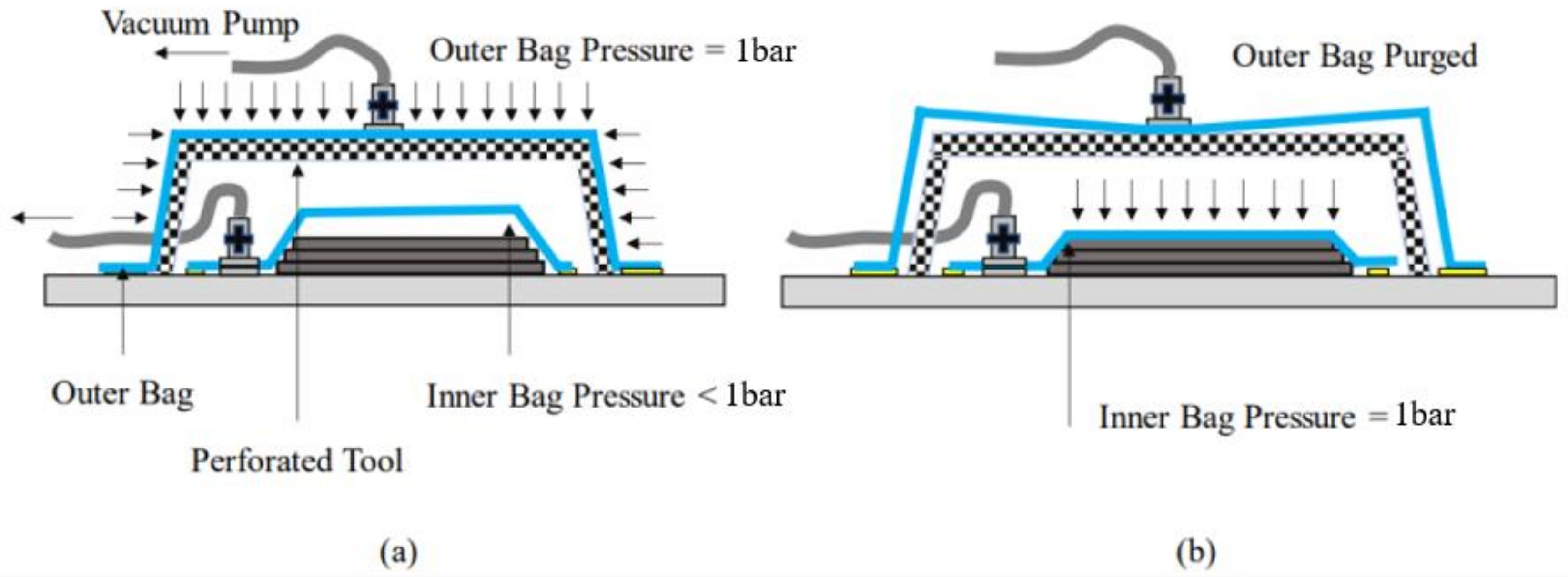

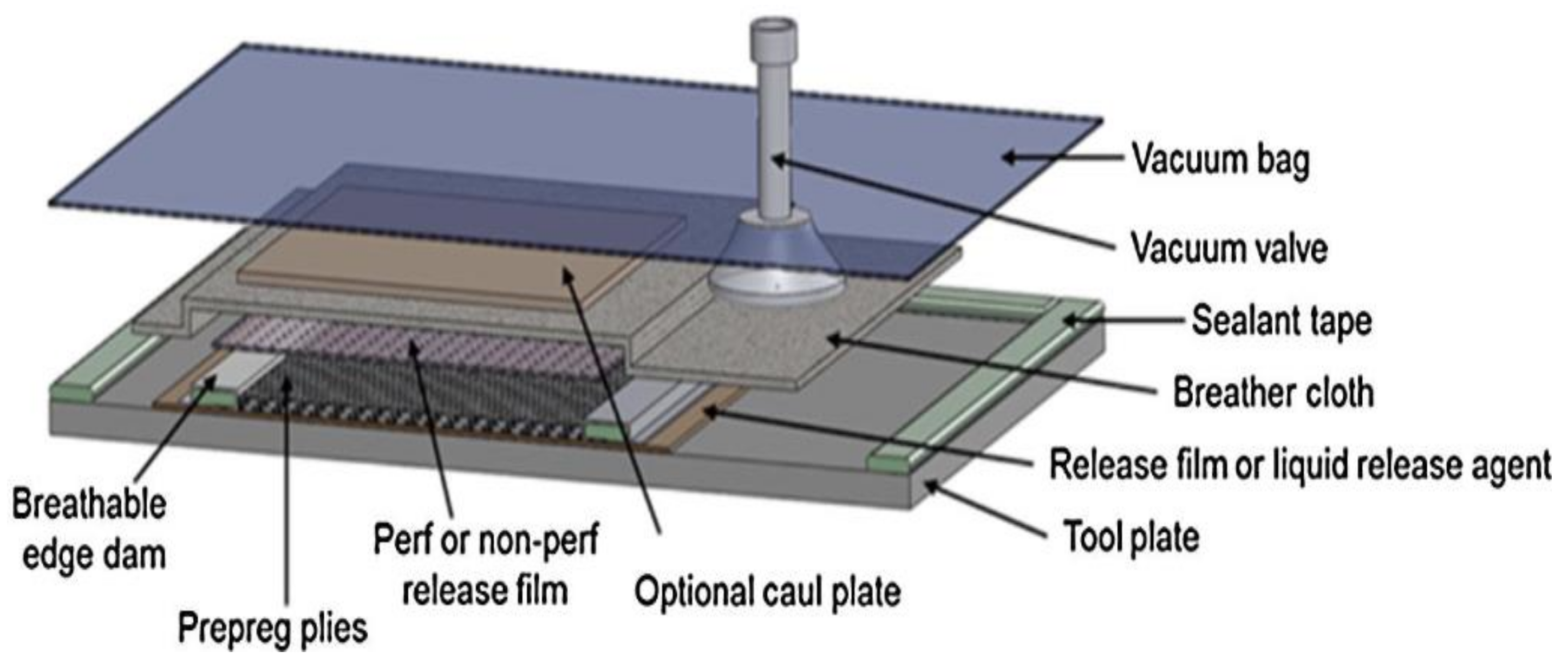

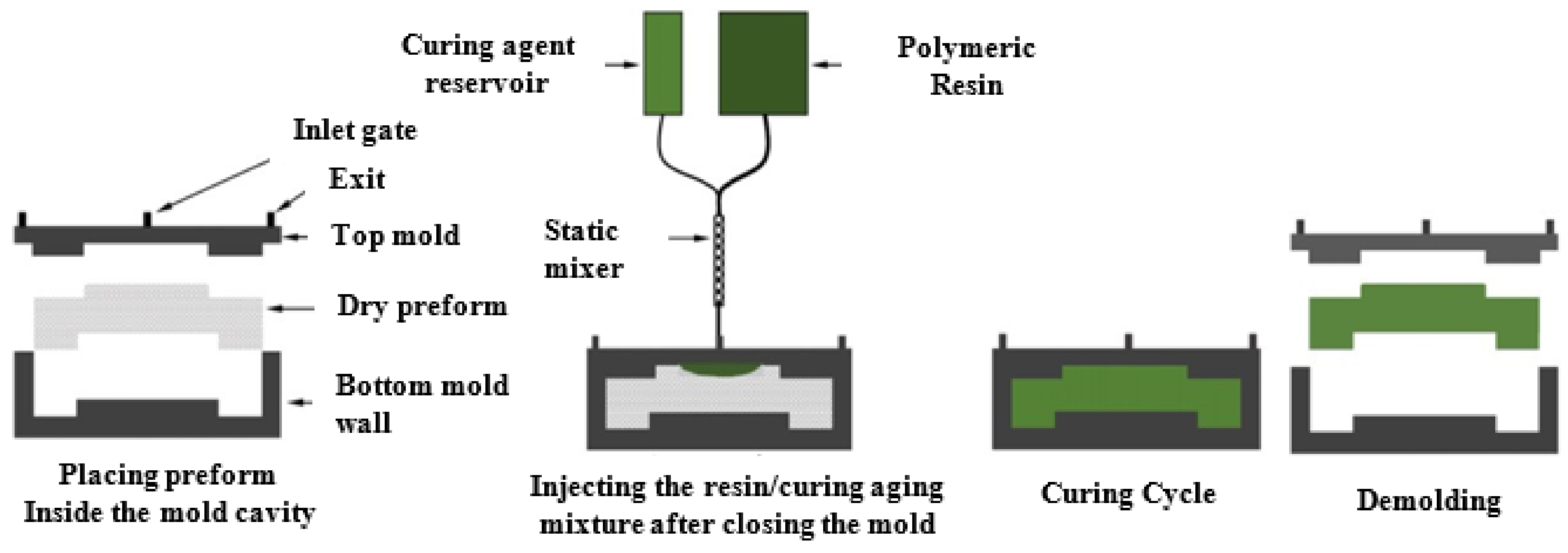
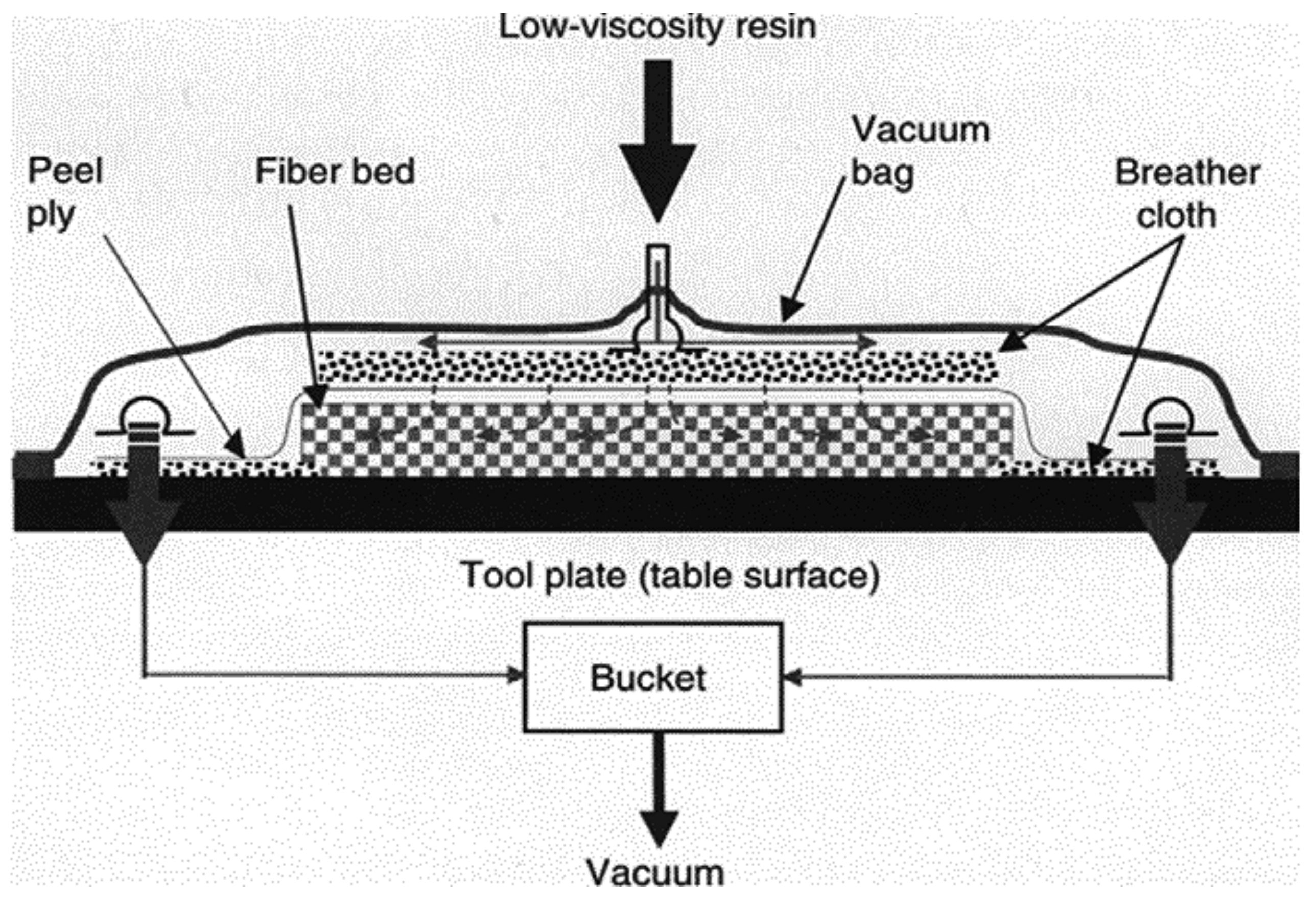
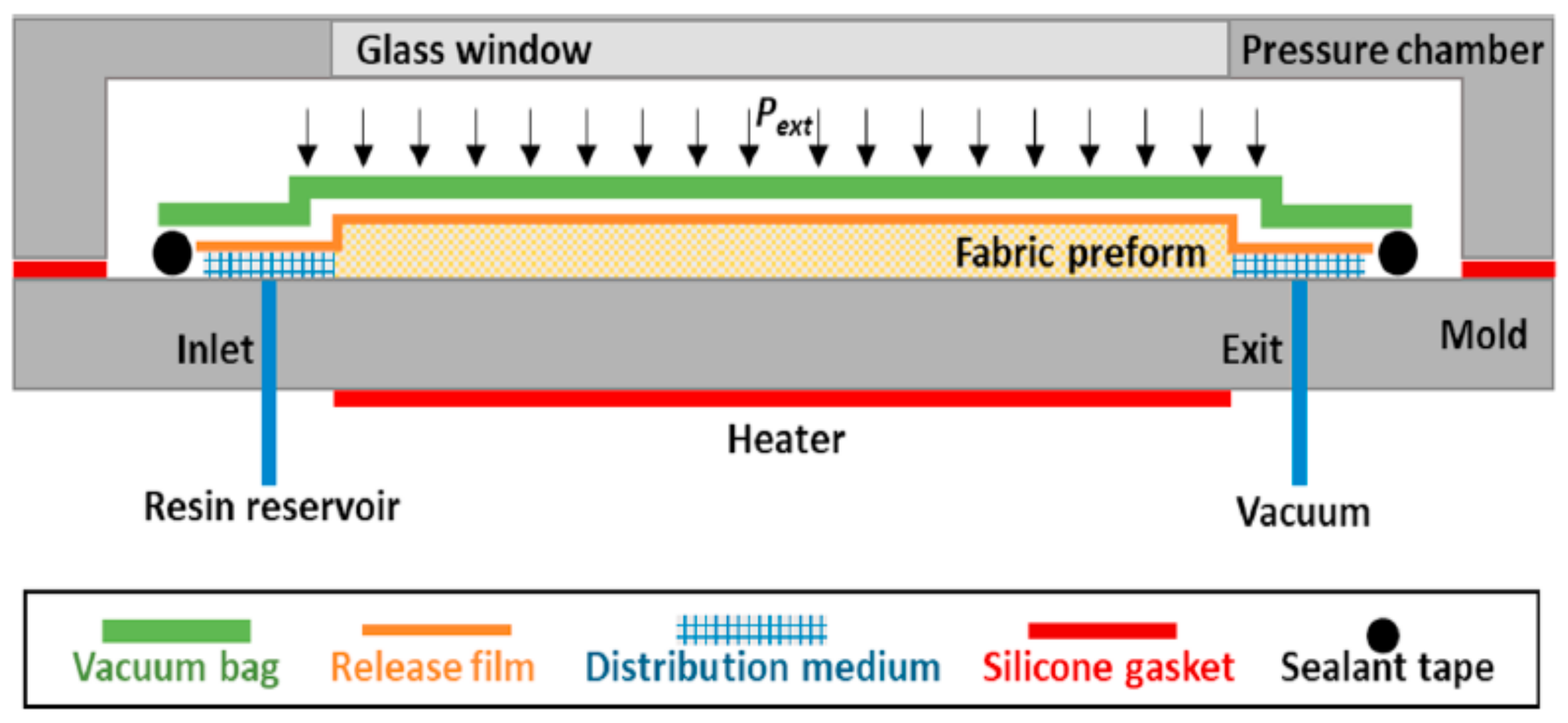

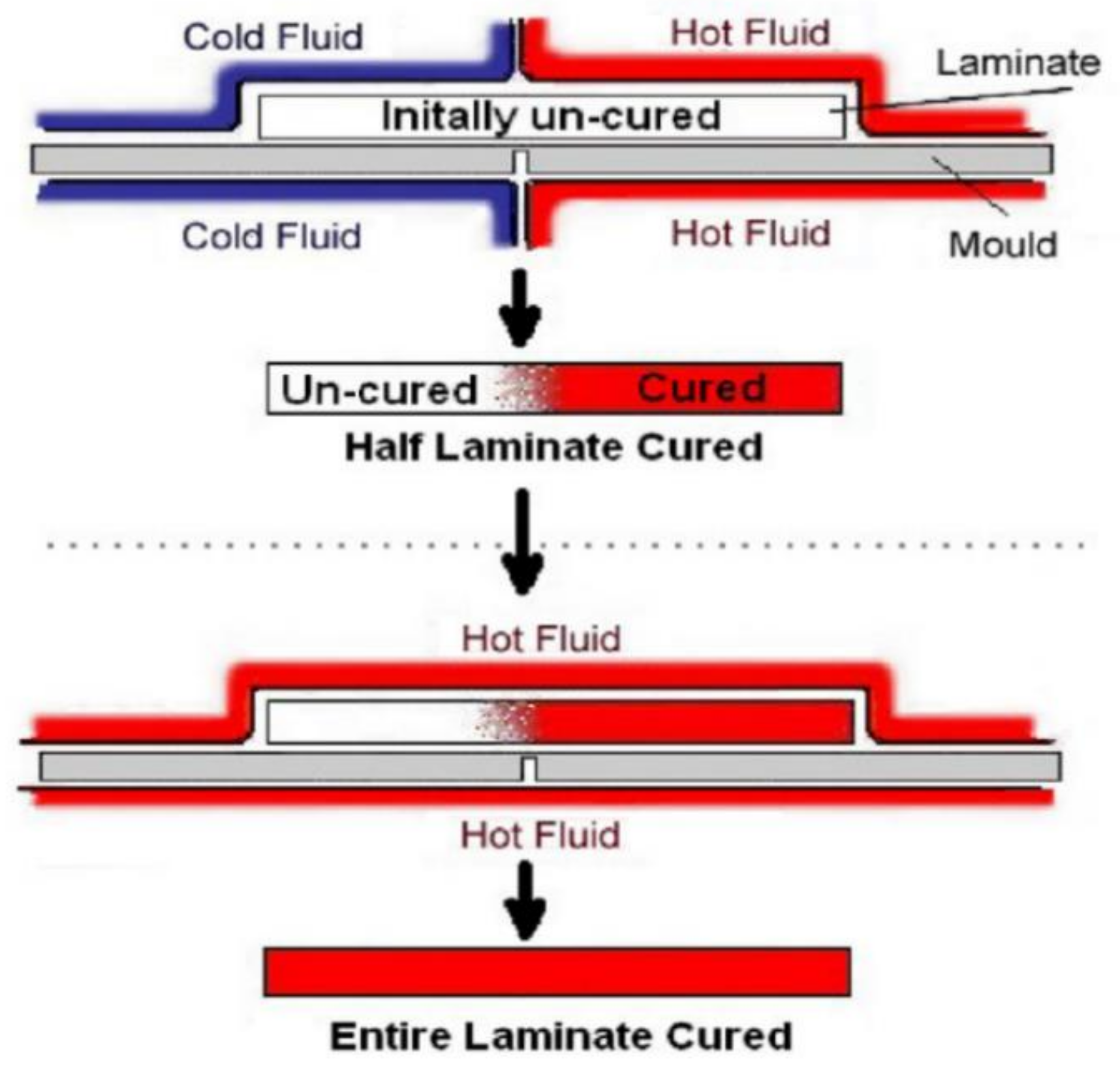

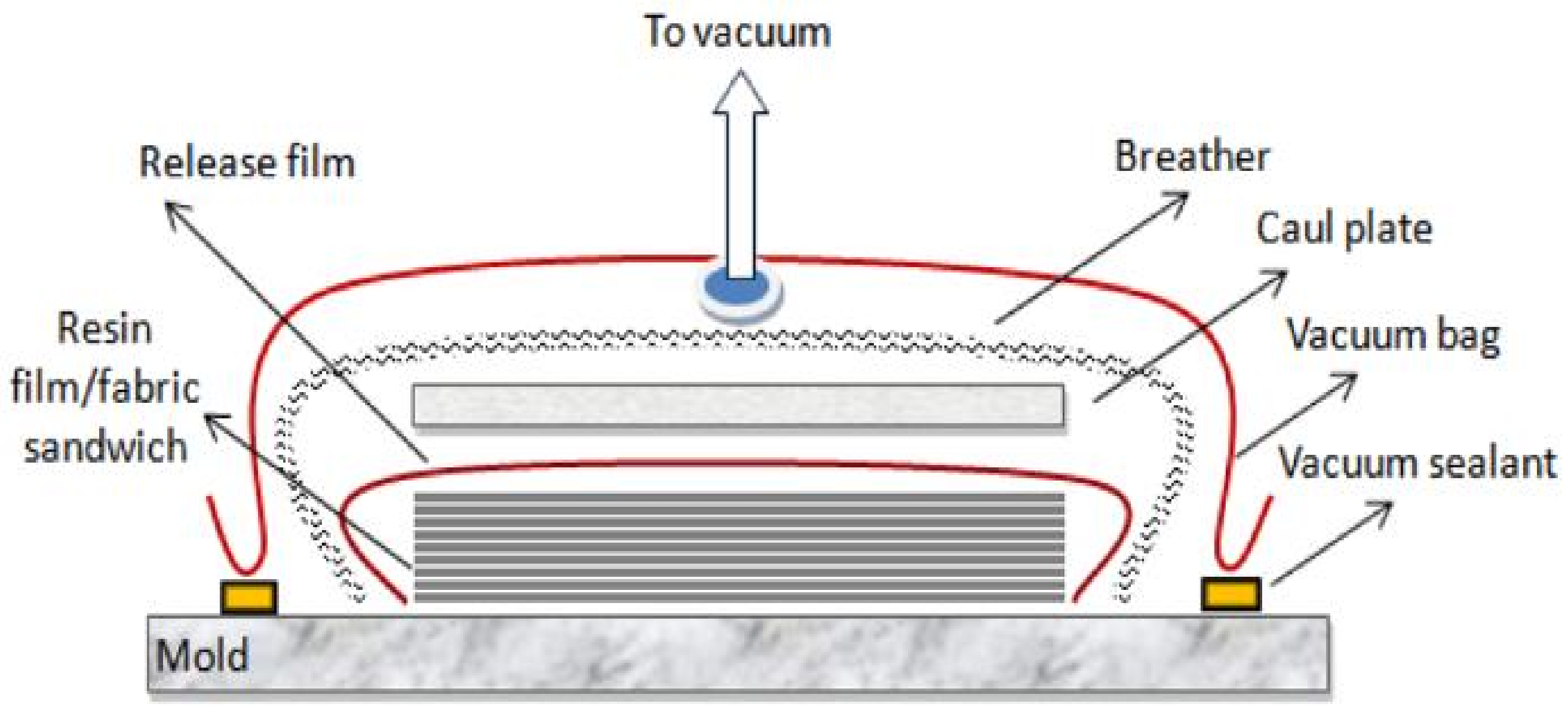


| Component | Function |
|---|---|
| Release Agent | Permits the release of the cured prepreg from the tool. |
| Peel Ply | A porous material that allows the passage of excess resin to flow through it during curing. It aids the removal of the bagging system from the parts after curing. An example of this material is a perforated Teflon sheet. |
| Release Film (separator) | A lightly porous material that permits the flow of air and volatiles only unto the breather; however, it restricts the further flow of resin. |
| Bleeder Fabric | Typically, a fiberglass mat that absorbs excess resin as it flows out during the molding process. |
| Breather Fabric | A highly porous material that allows the removal of air and volatiles from the composite assembly. Examples of breather materials are fiberglass, polyester felt, and cotton. |
| Vacuum Bag /Sealant Tape | A sticky polymeric tape placed around the entire assembly to provide an airtight seal vacuum bag. |
| Manufacturer | Resin Family | Resin Type | Description |
|---|---|---|---|
| ACG (now Cytec) | MTM44-1 | Epoxy | Medium temperature molding (MTM) toughened epoxy. Qualified by Airbus® for secondary and tertiary structure. |
| MTM45-1 | Epoxy | Lower temperature cure system optimized for compression performance. | |
| Cytec | Cycom 5320 | Epoxy | Toughened epoxy designed for primary structure application. |
| Hexcel | Hexply M56 | Epoxy | High-performance VBO epoxy system. |
| Tencate | BT250E | Epoxy | Standard VBO system used in circus aircraft and unmanned vehicles. Variations for fatigue and fracture resistance for helicopter rotor blades. |
| TC250 | Epoxy | Second generation VBO system with increased toughness and higher service temperature. | |
| TC275 | Epoxy | Third generation system with greater inspectability, resistance to hot/wet conditioning, and curable at 135 °C. | |
| TC350-1 | Epoxy | Third generation system with increased out-life (45 ± days), high toughness, and ability to cure at 135 °C with 177 °C required post-cure. | |
| Henkel | Loctite BZ | Benzoxazine | VBO prepreg based on a blended epoxy-benzoxazine resin formulation. |
| Toray | 2510 | Epoxy | Formulated to meet the requirements of general aviation primary structure. |
| Cure Cycle | 1st RT °C/min | 1st D/T °C & min | 1st CT °C/min | 2nd RT °C/min | 2nd D/T °C & min | 3rd RT °C/min | 3rd D/T °C & min | Ref. |
|---|---|---|---|---|---|---|---|---|
| Q1 | 17 | 132/45 | [90] | |||||
| Q2 | 17 | 132/60 | ||||||
| Q3 | 17 | 140/45 | ||||||
| Q4 | 17 | 140/60 | ||||||
| Q1 | 10 | 175/0.02 | 5 | 125/120 | [84] | |||
| Q2 | 10 | 135/35 | 5 | 175/60 | ||||
| Q3 | 8 | 110/30 | 7 | 180/60 | ||||
| A1 | 55 | 135/30 | 20 | 175/60 | ||||
| QSDirect | 10–12 | 180/180 | [89] | |||||
| QSID | 10–12 | 130/60 | 10–12 | 180/120 | ||||
| QSAD | 10–12 | 175/10 | 10–12 | 130/35, 45, 60, 75 | 10–12 | 180/120 | ||
| Autoclave | 2 | 130/60 | 2 | 180/120 | ||||
| QSspike | 10 | 175/0 | 8 | 130/120 | 10 | 175/120 | [88] | |
| QSdwell | 10 | 130/20 | 10 | 175/120 | ||||
| QSstraight | 10 | 175/120 | ||||||
| Autoclave | 2 | 175/120 |
| Cure Cycle | Fiber Vol. Fraction | Void Content | ILSS | Flexural Strength | Glass Temperature | Ref. |
|---|---|---|---|---|---|---|
| Q1 | 61.6 | 150 | [90] | |||
| Q2 | 153 | |||||
| Q3 | 153 | |||||
| Q4 | 157 | |||||
| Q1 | 208 | [84] | ||||
| Q2 | 207 | |||||
| Q3 | 207 | |||||
| A1 | 200 | |||||
| QSDirect | 54.6 | 6.1 | 54 | 1019 | [89] | |
| QSID | 57 | 4.8 | 65 | 1129 | ||
| QSAD (60 min) | 61 | 1.7 | 84 | 1258 | ||
| Autoclave | 63 | 0.8 | 81 | 1389 | ||
| QSspike | 60 | 1.8 | 115 | 1755 | [88] | |
| QSdwell | 55 | 8.1 | 84 | 1477 | ||
| QSstraight | 49 | 12.3 | 71 | 1322 | ||
| Autoclave | 64 | 0.6 | 111 | 1923 |
| Principle | Advantage | Disadvantage | |
|---|---|---|---|
| VBO | Partial impregnated prepreg is cured in an oven | Low investment Large number of parts per production cycle Easy to use Similar part quality with autoclave | Long processing time Lesser heat transfer than autoclave Comparatively high energy consumption Limited space, hence batch production. |
| RTM | In plane resin infusion (with injection pressure) using two sided-mold | Lesser void content Produce complex parts Two side has high surface finished | Labor intensive preform preparation High tooling cost 3D resin flow problematic to control |
| VARTM | In plane resin infusion (with vacuum pressure) using two sided-mold | Cheap raw material Low tooling cost 2D impregnation easy to control Reduce volatile emission | High processing cycle time High process complexity Limitation to achieve desirable fiber volume fraction Require low viscosity resin One sided high surface finish |
| SCRIMP | In plane resin infusion (with vacuum pressure) using two sided-mold, with flow media | Higher dimensional consistency Better quality products than RTM Reduce volatile emission Use for large scale structure | Propriety process One side finished High permeability preforms required |
| Quickstep | Vacuum bagged laminate is cured using high heating from heat transfer fluid (HTF) | Higher heat transfer rates Use Low pressure Precise temperature control Restraint of exotherm | Uses HTF for Heat transfer Limited to medium complexity parts Limited life span of flexible membrane |
| RFI | Through-thickness resin infusion, with resin film between fiber layers | Produce good quality parts Resin easily toughened Repeated debulking operation not need | Expensive material Hard to fabricate complex shaped parts Resin film placement inside mold requires high labor |
| RIDFT | In plane resin infusion (with vacuum) using two sided-flexible molds | Uses low-cost resin materials Easily control 2D impregnation | Flexible tooling may be easily damaged Requires low viscosity resin |
Publisher’s Note: MDPI stays neutral with regard to jurisdictional claims in published maps and institutional affiliations. |
© 2022 by the authors. Licensee MDPI, Basel, Switzerland. This article is an open access article distributed under the terms and conditions of the Creative Commons Attribution (CC BY) license (https://creativecommons.org/licenses/by/4.0/).
Share and Cite
Ekuase, O.A.; Anjum, N.; Eze, V.O.; Okoli, O.I. A Review on the Out-of-Autoclave Process for Composite Manufacturing. J. Compos. Sci. 2022, 6, 172. https://doi.org/10.3390/jcs6060172
Ekuase OA, Anjum N, Eze VO, Okoli OI. A Review on the Out-of-Autoclave Process for Composite Manufacturing. Journal of Composites Science. 2022; 6(6):172. https://doi.org/10.3390/jcs6060172
Chicago/Turabian StyleEkuase, Okunzuwa Austine, Nafiza Anjum, Vincent Obiozo Eze, and Okenwa I. Okoli. 2022. "A Review on the Out-of-Autoclave Process for Composite Manufacturing" Journal of Composites Science 6, no. 6: 172. https://doi.org/10.3390/jcs6060172






